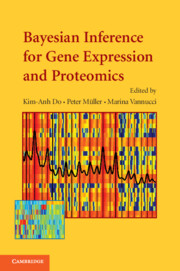Book contents
- Frontmatter
- Contents
- List of Contributors
- Preface
- 1 An Introduction to High-Throughput Bioinformatics Data
- 2 Hierarchical Mixture Models for Expression Profiles
- 3 Bayesian Hierarchical Models for Inference in Microarray Data
- 4 Bayesian Process-Based Modeling of Two-Channel Microarray Experiments: Estimating Absolute mRNA Concentrations
- 5 Identification of Biomarkers in Classification and Clustering of High-Throughput Data
- 6 Modeling Nonlinear Gene Interactions Using Bayesian MARS
- 7 Models for Probability of Under- and Overexpression: The POE Scale
- 8 Sparse Statistical Modelling in Gene Expression Genomics
- 9 Bayesian Analysis of Cell Cycle Gene Expression Data
- 10 Model-Based Clustering for Expression Data via a Dirichlet Process Mixture Model
- 11 Interval Mapping for Expression Quantitative Trait Loci
- 12 Bayesian Mixture Models for Gene Expression and Protein Profiles
- 13 Shrinkage Estimation for SAGE Data Using a Mixture Dirichlet Prior
- 14 Analysis of Mass Spectrometry Data Using Bayesian Wavelet-Based Functional Mixed Models
- 15 Nonparametric Models for Proteomic Peak Identification and Quantification
- 16 Bayesian Modeling and Inference for Sequence Motif Discovery
- 17 Identification of DNA Regulatory Motifs and Regulators by Integrating Gene Expression and Sequence Data
- 18 A Misclassification Model for Inferring Transcriptional Regulatory Networks
- 19 Estimating Cellular Signaling from Transcription Data
- 20 Computational Methods for Learning Bayesian Networks from High-Throughput Biological Data
- 21 Bayesian Networks and Informative Priors: Transcriptional Regulatory Network Models
- 22 Sample Size Choice for Microarray Experiments
- Plate section
18 - A Misclassification Model for Inferring Transcriptional Regulatory Networks
Published online by Cambridge University Press: 23 November 2009
- Frontmatter
- Contents
- List of Contributors
- Preface
- 1 An Introduction to High-Throughput Bioinformatics Data
- 2 Hierarchical Mixture Models for Expression Profiles
- 3 Bayesian Hierarchical Models for Inference in Microarray Data
- 4 Bayesian Process-Based Modeling of Two-Channel Microarray Experiments: Estimating Absolute mRNA Concentrations
- 5 Identification of Biomarkers in Classification and Clustering of High-Throughput Data
- 6 Modeling Nonlinear Gene Interactions Using Bayesian MARS
- 7 Models for Probability of Under- and Overexpression: The POE Scale
- 8 Sparse Statistical Modelling in Gene Expression Genomics
- 9 Bayesian Analysis of Cell Cycle Gene Expression Data
- 10 Model-Based Clustering for Expression Data via a Dirichlet Process Mixture Model
- 11 Interval Mapping for Expression Quantitative Trait Loci
- 12 Bayesian Mixture Models for Gene Expression and Protein Profiles
- 13 Shrinkage Estimation for SAGE Data Using a Mixture Dirichlet Prior
- 14 Analysis of Mass Spectrometry Data Using Bayesian Wavelet-Based Functional Mixed Models
- 15 Nonparametric Models for Proteomic Peak Identification and Quantification
- 16 Bayesian Modeling and Inference for Sequence Motif Discovery
- 17 Identification of DNA Regulatory Motifs and Regulators by Integrating Gene Expression and Sequence Data
- 18 A Misclassification Model for Inferring Transcriptional Regulatory Networks
- 19 Estimating Cellular Signaling from Transcription Data
- 20 Computational Methods for Learning Bayesian Networks from High-Throughput Biological Data
- 21 Bayesian Networks and Informative Priors: Transcriptional Regulatory Network Models
- 22 Sample Size Choice for Microarray Experiments
- Plate section
Summary
Abstract
One major goal in biological research is to understand how genes are regulated through transcriptional regulatory networks. Recent advances in biotechnology have generated enormous amounts of data that can be utilized to better achieve this goal. In this chapter, we develop a general statistical framework to integrate different data sources for transcriptional regulatory network reconstructions. More specifically, we apply measurement error models for network reconstructions using both gene expression data and protein–DNA binding data. A linear misclassification model is used to describe the relationship between the expression level of a specific gene and the binding activities of the proteins (transcription factors) that regulate this gene. We propose Markov chain Monte Carlo method for statistical inference based on this model. Extensive simulations are conducted to evaluate the performance of this model and assess the sensitivity of its performance when the model parameters are misspecified. Our simulation results suggest that our approach can effectively integrate gene expression data and protein–DNA binding data to infer transcriptional regulatory networks. Lastly, we apply our model to jointly analyze gene expression data and protein–DNA binding data to infer transcriptional regulatory networks in the yeast cell cycle.
Introduction
Understanding gene regulations through the underlying transcriptional regulatory networks (referred as TRNs in the following) is a central topic in biology. A TRN can be thought of as consisting of a set of proteins, genes, small modules, and their mutual regulatory interactions. The potentially large number of components, the high connectivity among various components, and the transient stimulation in the network result in great complexity of TRNs.
- Type
- Chapter
- Information
- Bayesian Inference for Gene Expression and Proteomics , pp. 347 - 365Publisher: Cambridge University PressPrint publication year: 2006



